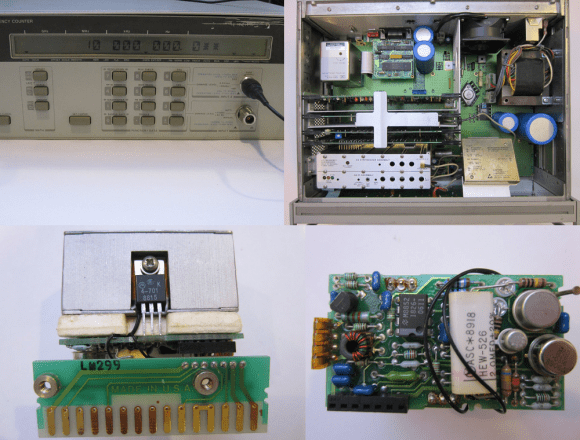
[Kerry Wong] recently got himself a frequency counter. Not just any counter, a classic Hewlett-Packard 5350B Microwave Counter. This baby will go 10Hz all the way up to 20GHz with only one input shift. A true fan of Hackaday Prize judge [Dave Jones], [Kerry] didn’t turn it on, he took it apart. In the process, he gave us some great pictures of late 80’s vintage HP iron.
Everything seemed to be in relatively good working order, with the exception of the oven indicator, which never turned off. The 5350B had three time bases available: a Thermally Compensated Crystal Oscillator (TCXO), an Oven Controlled Crystal Oscillator (OCXO), and a high stability OCXO. [Kerry’s] 5350B had option 001, the OCXO. Considering it was only a $750 USD upgrade to the 5350B’s $5500 USD base price, it’s not surprising that many 5350B’s in the wild have this option.
[Kerry] checked the wattage of his 5350B, and determined that it pulled about 27 watts at power up and stayed there. If the OCXO was working, wattage would have dropped after about 10 minutes when the oven came up to temperature. Time to tear open an oven!
Armed with a copy of the 5350B service manual from HP’s website, [Kerry] opened up his OCXO. The Darlington transistors used as heaters were fine. The control circuit was fine. The problem turned out to be a simple thermal fuse. The service manual recommended jumping out the fuse for testing. With the fuse jumped, the oven came to life. One more piece of classic (and still very useful) test equipment brought back to full operation.
[via Dangerous Prototypes]














This thing looks in excellent condition despite the fact that it’s so old. Was it never used or did someone take really good care of it? Also, how much do you suppose it would cost to replace the fuse?
Aside from all that, I’m a bit surprised to see a solid-state part being used for its heating characteristics for a positive effect. Normally you would want to avoid heating problems. You learn something new everyday.
It’s quite possible that it was never used. We have a lot of equipment in our university lab that has been unpacked, but not even switched on once…
>The problem turned out to be a simple thermal fuse.
That’s a regular fuse, not a thermal fuse. There is a huge* difference.
It is probably one of these. http://www.littelfuse.com/products/fuses/axial-radial-thru-hole-fuses/pico-fuses.aspx
Wouldn’t you at least expect a temperature marking on a *thermal* fuse is rated for on the package?
Well, it was probably just a normal fuse. But the service manual does refer to it as thermal fuse and this is the only fuse inside the oven.
I wonder if someone got in there before you and replaced the thermal with a standard 1/8th watt fuse?
There is usually a BOM in the service manual that tells you the part# and a description with the rating of their parts on each of the assembly. If it were a thermal fuse (to protect against overheating), it would normally be thermally attached to the heating transistor.